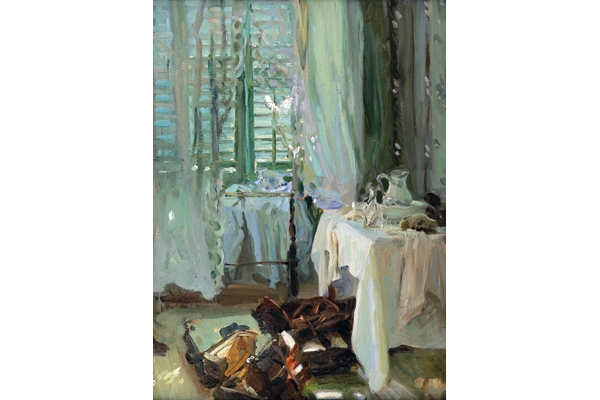Why did Florence become a hotspot for Americans in the late 19th and early 20th century? Henry James, Edith Wharton, John Singer Sargent and a gang of other American artists and writers descended on the Arno, often for years at a time. Sargent, born in Florence, the son of a Philadelphia eye surgeon, didn’t get to see America until he was 20. This engaging — if chaotic — exhibition answers the question.
The Grand Tour had been around since the 16th century, first for the aristocracy and then for the bourgeoisie of northern Europe; Americans were part of the artistic immigrant crowd from the mid-18th century. But it was only at the end of the Civil War that a critical mass of Americans had the security — and money — to roam the Continent at leisure, their travel smoothed by European railways and transatlantic steamers.
Like his compatriots Sargent and Whistler, Henry James was one of these ‘hotel children’, born to rich, cosmopolitan parents, whose Grand Tours could last for decades. The show includes Sargent’s marvellous portrait of Henry James. With his wing collar, spreading, pin-striped waistcoat and watch chain, James looks the picture of plump prosperity — an American Captain Mainwaring. His lips are parted; he is about to speak, it seems — the moment, Bernini said, when people are at their most characteristic.
Sargent is the star of the show. Unlike lots of other artists in the exhibition, he had extremely strong Florentine and Italian connections. The inspiration behind Sargent’s ‘The Hotel Room’ was probably in Rome, but it might as well be in Florence — you can feel the powerful southern heat and light through the shuttered window, the harsh rays striking the jumble of half-unpacked luggage we all dump in our hotel rooms.
As a genuine native of the city, Sargent avoided the Greatest Hits of Florence, except to play around with them. There’s an entertaining capriccio, which takes a view of Vasari’s portico at the Uffizi, removes the Arno and replaces it with a chunk of the Boboli Gardens, transplanted from the other side of the river. But his eyes are at their most acute far from Tourist Florence. His most original picture is of a strettitoio — a sort of winepress — being turned by three straining peasants in a dimly-lit back street, the blood-red grapes staining the barrels and floor in shades of pale violet.
Sargent apart, there’s a rather ragbag feeling to this show — the curators have scrabbled around for any picture with a vague American or a Florentine connection, as opposed to one with feet in both camps. So you get the portrait of George W. Vanderbilt by Whistler; a terrific picture, certainly, a study in greys of a stretched, etiolated Vanderbilt, looking like an anorexic Proust. But, as the catalogue admits, Massachusetts-born Whistler lived in London for 40 years and visited Rome only once, ‘taking the opportunity to spend a few days in Florence’. So, yes, he was an American in Florence, but only just.
‘What’s this doing here?’ you keep on asking yourself of things such as a late-Victorian seaside picture of Shinnecock, New York by William Merritt Chase. Chase did spend a lot of time in Florence — and there are some pretty enough pictures by him of Italian gardens and olive groves in the exhibition — but why pad them out with an American scene?
You ask the question again of pictures by Italians of Florence, like the Lorenzo Gelati of the banks of the Arno near Ponte San Niccolo, painted in 1869. Not much of an American connection here but, again, a lovely picture — of Italian fishermen standing by their boats, their bed sheets dangling from a washing line strung between two timber shacks. A charmingly pathetic Italian tricolore hangs limply from a crooked tree trunk. Down here, by the river, it seems the spirit of Italian Unification has faded a little.
Still, at the end of this curious exhibition, you do leave knowing a lot more about the Americans who flocked to Florence ‘randy for antique’, in Larkin’s phrase. Some stayed on for ever, like Hortense Mitchell, heiress to the Chicago banking fortune that subsidised her art-dealer husband, Arthur Acton. When their older son, Sir Harold, died in 1994, he was held up as the last of the quintessentially English, white-suited aesthetes of Florence; but it was American dollars that paid for Villa La Pietra, his Renaissance palazzo high on the hills above the city.
Recognition of the American contribution to Florence is long overdue; if only this show had been a little bit more focused in highlighting that contribution.






Comments